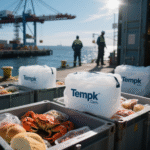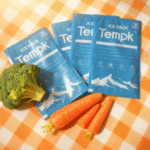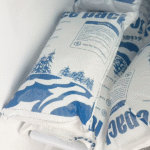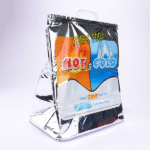Introducción
Mantener temperaturas precisas durante el transporte es el corazón de una logística exitosa de la cadena de frío. Sistemas de refrigeración con láminas de hielo seco entregar consistente, temperaturas ultrabajas que protegen los productos perecederos, vacunas, y productos biológicos del deterioro. En esta guía, Descubrirá cómo estas innovadoras láminas mejoran el control de la temperatura, mejorar la eficiencia operativa, y respaldar la logística sostenible, todo ello cumpliendo con los últimos estándares de la industria para 2025..
-
¿Cómo mejoran las láminas de hielo seco la estabilidad de la temperatura durante el envío??
-
¿Qué medidas de seguridad son imprescindibles al manipular láminas de hielo seco??
-
¿Cómo pueden las empresas integrar eficazmente los sistemas de refrigeración??
-
¿Cuáles son las consideraciones ambientales y regulatorias??
-
cuales son las ultimas 2025 Tendencias de la cadena de frío que impulsan la innovación.?
¿Cómo mantienen las láminas de hielo seco el control de la temperatura durante el transporte??
Las láminas de hielo seco mantienen condiciones bajo cero sin derretirse ni acumularse humedad., asegurar que los productos permanezcan secos, frío, y seguro. A diferencia del hielo normal, lo que añade humedad no deseada, El hielo seco se sublima directamente en gas CO₂, manteniendo un frío constante y eliminando la condensación..
Esto los hace ideales para productos farmaceuticos, mariscos, y alimentos congelados que deben permanecer por debajo de los umbrales de temperatura críticos. Personalizando la cantidad y el tipo de aislamiento., las empresas pueden preservar la integridad del producto durante los envíos de larga distancia.
Mejores prácticas para el control de temperatura
| Método de embalaje | Tipo de aislamiento | Duración esperada | Beneficiarte para ti |
|---|---|---|---|
| Contenedor de espuma de poliestireno | Alto | Arriba a 48 horas | Mantiene una frescura premium para rutas largas. |
| Caja de cartón aislada | Medio | 24 horas | Práctico para entrega local o el mismo día |
| Panel aislado al vacío | Superior | 72 horas + | Ideal para productos farmacéuticos y largos recorridos de exportación |
Consejo: Supervise siempre las temperaturas internas con sensores IoT o registradores de datos para verificar el cumplimiento durante el tránsito.
Ejemplo del mundo real: Un exportador de productos del mar utilizó láminas de hielo seco multicapa con cajas de poliestireno y logró un 40% reducción del deterioro, Mantener la calidad del producto durante una ruta aérea de 48 horas..
¿Qué medidas de seguridad se requieren al usar láminas para bolsas de hielo seco??
La seguridad es crucial al manipular hielo seco, mientras se sublima en gas CO₂, que puede desplazar el oxígeno en áreas cerradas. Asegúrese siempre de una ventilación adecuada y utilice recipientes ventilados para liberar el gas acumulado.. El contacto directo con hielo seco puede provocar congelación, por lo que los guantes aislantes son obligatorios.
Pautas de seguridad de un vistazo
| Paso de seguridad | Descripción | Por que importa |
|---|---|---|
| Ventilación | Trabajar en espacios bien ventilados. | Prevenir la acumulación de CO₂ |
| protección personal | Utilice guantes aislantes y protectores faciales. | Evite las quemaduras por frío |
| Etiquetado adecuado | Marcar como “Hielo seco – ONU 1845” | Garantizar el cumplimiento de las normas de transporte IATA/DOT |
Consejos adicionales:
-
Nunca selle el hielo seco en recipientes herméticos..
-
Capacitar a todo el personal de logística sobre respuesta a emergencias y etiquetado de peligros..
-
Incluir hojas de datos de seguridad de materiales (MSDS) con cada envío.
¿Cómo mejoran las láminas de hielo seco la eficiencia de la cadena de suministro??
Hojas de hielo seco agilice las operaciones ofreciendo un peso ligero, refrigeración sin residuos que requiere un mantenimiento mínimo. Su flexibilidad y escalabilidad permiten su uso en diversos tamaños de carga, desde kits de comida hasta muestras médicas..
Ventajas clave para las operaciones de la cadena de frío:
-
Peso reducido: Más ligero que los paquetes de gel o el hielo de agua., reduciendo los costos de flete.
-
Duración más larga: Mantiene el frío hasta 72 horas dependiendo del aislamiento.
-
Uso versátil: Cortar, doblar, o apilar para que coincida con cualquier tamaño de paquete.
-
Proceso más limpio: Sin residuos de agua ni riesgo de moho.
Perspectiva del caso: Una empresa de biotecnología que envía muestras de ARN reemplazó los paquetes de gel con láminas de hielo seco y redujo los costos en 22% mientras se cumple con el cumplimiento de temperatura de la OMS.
¿Cuáles son las consideraciones ambientales y regulatorias??
Mientras que el hielo seco está hecho de CO₂, es La huella ambiental se puede minimizar. mediante el uso de fuentes capturadas de emisiones industriales, convirtiendo el carbono residual en un valioso refrigerante. Muchos proveedores ofrecen ahora soluciones de hielo seco neutras en carbono.
Descripción general de sostenibilidad y cumplimiento
| Factor | Descripción | Beneficio |
|---|---|---|
| Producción de CO₂ capturada | Hecho de gas industrial reciclado | Reduce las emisiones netas |
| Embalaje reutilizable | Cajas aisladas o sistemas híbridos PCM | Minimiza el desperdicio |
| Normas regulatorias | IATA / PUNTO / BRC / Logística certificada SQF | Garantiza el cumplimiento global |
Consejo: Combine hielo seco con paneles PCM reutilizables para lograr una refrigeración híbrida que equilibre la sostenibilidad y el rendimiento..
¿Cómo pueden las empresas implementar sistemas de refrigeración con láminas de hielo seco de forma eficaz??
La implementación de estos sistemas requiere evaluar el tipo de envío., ruta, y temperatura ambiente. Comience con una prueba piloto para determinar el espesor óptimo del aislamiento y la cantidad de láminas..
Lista de verificación de implementación
-
Evaluar las condiciones de transporte: Determinar el rango de temperatura, sensibilidad de carga, y duración del tránsito.
-
Personal del tren: Centrarse en el manejo, ventilación, y cumplimiento regulatorio.
-
Integrar sensores de IoT: Habilite el monitoreo en tiempo real y alertas predictivas.
-
Colabora con especialistas: Asóciese con proveedores certificados de cadena de frío para configuraciones personalizadas.
Ejemplo práctico: Un distribuidor regional de vacunas introdujo la logística de hielo seco habilitada por IoT y logró 99.8% cumplimiento de la temperatura al otro lado de 200 entregas en 2025.
2025 Tendencias e innovaciones de la cadena de frío
La industria de la cadena de frío está evolucionando hacia elegante, sostenible, y soluciones automatizadas. En 2025, Varias tendencias importantes están cambiando la forma en que las empresas utilizan los sistemas de refrigeración con hielo seco..
Tecnologías emergentes
-
Integración de IoT e IA: Seguimiento de temperatura y humedad en tiempo real con alertas automáticas.
-
Trazabilidad de la cadena de bloques: Historiales de envío transparentes para el cumplimiento farmacéutico.
-
Fabricación ecoeficiente: Hielo seco elaborado a partir de CO₂ capturado y alimentado con energía renovable.
-
Sistemas de enfriamiento híbrido: Combinando PCM con hielo seco para una mayor duración y reutilización.
Insight del mercado (2025):
El mercado mundial de la cadena de frío alcanzó Dólar estadounidense 418 mil millones y se prevé que supere Dólar estadounidense 1.4 billones por 2034 (CAGR ≈ 14.5%). Los sistemas de refrigeración sostenibles y la monitorización inteligente están impulsando este crecimiento exponencial.
Preguntas frecuentes
Q1: ¿Cuánto duran las láminas de hielo seco??
Normalmente entre 24 y 72 horas, según la calidad del aislamiento., cantidad, y temperatura ambiente.
Q2: ¿Las láminas de hielo seco son reutilizables??
La mayoría son de un solo uso., pero los modelos PCM híbridos permiten múltiples ciclos para rangos de enfriamiento moderados.
Q3: ¿Es seguro enviar alimentos con láminas de hielo seco??
Sí, siempre que se utilicen envases ventilados y etiquetas adecuadas para liberar el gas CO₂ de forma segura.
Q4: ¿Cómo debo desechar las sábanas usadas??
Deje que el CO₂ restante se disipe completamente en un espacio ventilado., luego recicle el embalaje de acuerdo con las pautas locales.
Resumen y recomendaciones
Los sistemas de refrigeración con láminas de hielo seco están transformando la logística de la cadena de frío proporcionando temperaturas ultrabajas, operación más limpia, y rendimiento escalable. Para maximizar los beneficios:
-
Elija hielo seco ecológico procedente de fuentes de CO₂ capturadas.
-
Equipe los envíos con sensores de monitoreo en tiempo real.
-
Formar al personal en seguridad y cumplimiento normativo..
-
Explore la refrigeración híbrida para entregas de larga duración.
Siguientes pasos
-
Audite sus operaciones actuales de cadena de frío.
-
Seleccione la configuración adecuada de la hoja de bolsa de hielo seco para su carga y ruta.
-
Adopte herramientas de monitoreo inteligentes para una total transparencia en el envío.
-
Asóciese con expertos certificados en cadena de frío para optimizar costos y cumplimiento.
Acerca de Tempk
Templ se especializa en soluciones de cadena de frío de próxima generación diseñadas para la eficiencia, seguridad, y sostenibilidad. Nuestro Sistemas de refrigeración con láminas de hielo seco. Ofrecer un rendimiento de temperatura constante para productos farmacéuticos., alimentos, y biológicos. Con décadas de experiencia y un compromiso con la innovación., te ayudamos a realizar envíos más inteligentes, más seguro, y más verde.
Llamado a la acción:
Póngase en contacto con Tempk hoy para diseñar un solución personalizada de cadena de frío que protege sus productos y mejora su rendimiento logístico.






















